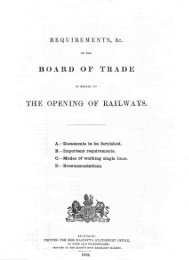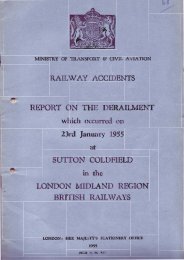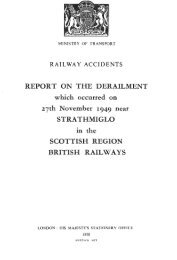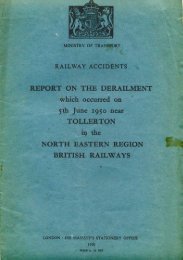R A I LT R AC K - The Railways Archive
R A I LT R AC K - The Railways Archive
R A I LT R AC K - The Railways Archive
You also want an ePaper? Increase the reach of your titles
YUMPU automatically turns print PDFs into web optimized ePapers that Google loves.
Route characteristics<br />
DESCRIPTION This is primarily a two-track railway, but with some short singletrack<br />
sections in Cornwall. Linespeeds east of Exeter are 80–110mph. West of<br />
Exeter speeds are lower, mostly between 40mph and 75mph.<br />
Some sections of the route are operating near to capacity. <strong>The</strong>se include<br />
Southcote Junction–Reading, Bristol Temple Meads–Weston-Super-Mare, Exeter<br />
St David’s–Plymouth, Saltash Bridge and the seven miles of single track between<br />
Burngullow and Probus in Cornwall.<br />
We are wo rking in part n e rship with local tra n s p o rt and land-use planning<br />
a u t h o rities to achieve a co-ordinated, sustainabl e, integrated tra n s p o rt system.<br />
Freight traffic on the route is growing, particularly aggregates, with new<br />
terminals opened at Newton Abbot, Plymouth and Heathfield. Our customers<br />
have aspirations for further growth, including intermodal traffic which will need<br />
loading-gauge improvements.<br />
Route vision<br />
Our vision is for a world-class rail transportation network for the South West.<br />
This vision was developed with the South West Government Office, regional<br />
development authority and local authorities together with our industry partners.<br />
We will reduce the peripherality of the South West through shortened journey<br />
times and enhanced freight capability.<br />
We will improve performance through initiatives such as continuing seadefence<br />
works at Dawlish, and reinstating the middle platform at Taunton.<br />
We will work with our partners to deliver reduced journey times. We will<br />
do this by agreeing a revenue-sharing framework and a package of infrastructure<br />
enhancements to maximise the benefits from our partners’ existing and<br />
proposed rolling-stock fleets.<br />
We expect this to deliver journey times of 2 hours 39 minutes<br />
London–Plymouth (19-minute improvement) and 4 hours 20 minutes<br />
London–Penzance (37-minute improvement).<br />
BOTTLENECK ANALYSIS In the 1998 NMS, Exeter–Plymouth was identified<br />
as a potential bottleneck. A number of constraints reduce capacity and timetable<br />
flexibility on this route, including the Weston-Super-Mare single-track loop,<br />
spacing of signals between Exeter and Plymouth and the single-track sections and<br />
long-signal sections in Cornwall. All of these impinge on the Exeter–Plymouth<br />
section of the route.<br />
Our detailed analysis, however, shows that there is sufficient capacity to run<br />
our customers’ proposed and forecast services until around 2008. <strong>The</strong> initiatives<br />
that we are undertaking to provide additional capacity (eg an extra platform at<br />
Taunton) are aimed primarily at achieving immediate performance improvements.<br />
We will be further evaluating options to increase capacity beyond 2008 as we<br />
and our customers develop firmer views of demand.<br />
We aspire to increase the public transport market share through provision of a<br />
more integrated transport system. We aim to improve branch line connections<br />
and to increase the quality of environment at key interchange locations.<br />
We look forward to working with Cornwall County Council to prepare the<br />
Objective 1 Bid to enhance further the county’s transport capabilities.<br />
We are working in partnership with local authorities in the Taunton area to<br />
fund a signalled connection to the West Somerset Railway and evaluate suitable<br />
locations for intermodal facilities in the area.<br />
We are considering increasing the gauge for freight trains on this route west<br />
of Bristol to connect with new terminal sites in Devon and Cornwall. We would<br />
do this by working in partnership with the Government office of the South West<br />
local authorities and our customers to agree a viable funding package.<br />
167








